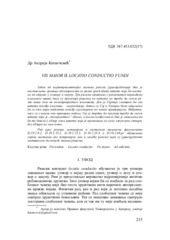Vis maior i locatio conductio fundi
Vis maior and locatio conductio fundi
Abstract
Jedan od najintrigantnijih izazova rimske jurisprudencije bio je postavljanje granica odgovornosti za rizik (periculum) štete koja bi nastala po strane u ugovoru o zakupu. Tri rimska pravnika u različitim periodima klasičnog prava dala su drugačija rešenja na pitanje ko treba da snosi rizik više sile na poljoprivrednom zemljištu. Dok je Servije smatrao da sva šteta pogađa vlasnika - zakupodavca, dotle su Gaj i Ulpijan bili mišljenja da se ona mora podeliti između saugovarača po nekom kriterijumu. Međutim, nisu se slagali oko principa podele. Gaj je tvrdio da zakupac treba da snosi štetu koja je ' tolerantnog ' obima, a njegov mlađi kolega bio je mišljenja da bi tu došla u obzir samo šteta koja je proizašla iz same zakupljene stvari, bez obzira na njen iznos. Rad kroz jezičko, istorijsko i sistemsko tumačenje fragmenata D.19.2.9.2, D.19.2.15.2, D.19.2.15.5, D.19.2.25.6 è D.19.2.49.pr objašnjava uzroke nastanka ove kotroverze, kao i moguće razloge koji su jurisprudente motivisali da ponu...de ovakva rešenja.
One of the most intriguing challenges for Roman jurisprudence was to delineate the boundaries of liability for the risk of damage connected to a lease contract. Three Roman jurists of different periods, in classical law, conflictingly opined on possible solutions related to the allocation of the risk of damage occurring on an agricultural property due to a vis maior event. While Servius advocated for the risk to be borne by the owner i.e. lessor, Ulpianus and Gaius argued that the risk should be divided between the parties to a contract, whilst the division of the risk was to be calculated in accordance with a certain prescribed criterion. Nonetheless, it appears that an agreement as to the principle of the division to be applied differed. On one hand, Gaius claimed that the lessee should bear the damages in so far as it is of 'tolerable' scope, while on the other, Ulpianus perceived that only damages arising out of the leased property should fall on the tenant, regardless of its scope.... This paper - through linguistic, historical and systematic interpretation of fragments D.19.2.9.2, D.19.2.15.2, D.19.2.15.5, D.19.2.25.6 and D.19.2.49.pr - attempts to explain the reasons behind this controversy, as well as possible reasons which motivated jurists to offer such diverging solutions.
Keywords:
Vis maior / Periculum / Locatio conductio / Ad edictum / Vis maior / Periculum / Locatio conductio / Ad edictumSource:
Anali Pravnog fakulteta u Beogradu, 2013, 61, 2, 215-229Publisher:
- Univerzitet u Beogradu - Pravni fakultet, Beograd
Collections
Institution/Community
Pravni fakultet / Faculty of Law University of BelgradeTY - JOUR AU - Katančević, Andreja PY - 2013 UR - https://ralf.ius.bg.ac.rs/handle/123456789/750 AB - Jedan od najintrigantnijih izazova rimske jurisprudencije bio je postavljanje granica odgovornosti za rizik (periculum) štete koja bi nastala po strane u ugovoru o zakupu. Tri rimska pravnika u različitim periodima klasičnog prava dala su drugačija rešenja na pitanje ko treba da snosi rizik više sile na poljoprivrednom zemljištu. Dok je Servije smatrao da sva šteta pogađa vlasnika - zakupodavca, dotle su Gaj i Ulpijan bili mišljenja da se ona mora podeliti između saugovarača po nekom kriterijumu. Međutim, nisu se slagali oko principa podele. Gaj je tvrdio da zakupac treba da snosi štetu koja je ' tolerantnog ' obima, a njegov mlađi kolega bio je mišljenja da bi tu došla u obzir samo šteta koja je proizašla iz same zakupljene stvari, bez obzira na njen iznos. Rad kroz jezičko, istorijsko i sistemsko tumačenje fragmenata D.19.2.9.2, D.19.2.15.2, D.19.2.15.5, D.19.2.25.6 è D.19.2.49.pr objašnjava uzroke nastanka ove kotroverze, kao i moguće razloge koji su jurisprudente motivisali da ponude ovakva rešenja. AB - One of the most intriguing challenges for Roman jurisprudence was to delineate the boundaries of liability for the risk of damage connected to a lease contract. Three Roman jurists of different periods, in classical law, conflictingly opined on possible solutions related to the allocation of the risk of damage occurring on an agricultural property due to a vis maior event. While Servius advocated for the risk to be borne by the owner i.e. lessor, Ulpianus and Gaius argued that the risk should be divided between the parties to a contract, whilst the division of the risk was to be calculated in accordance with a certain prescribed criterion. Nonetheless, it appears that an agreement as to the principle of the division to be applied differed. On one hand, Gaius claimed that the lessee should bear the damages in so far as it is of 'tolerable' scope, while on the other, Ulpianus perceived that only damages arising out of the leased property should fall on the tenant, regardless of its scope. This paper - through linguistic, historical and systematic interpretation of fragments D.19.2.9.2, D.19.2.15.2, D.19.2.15.5, D.19.2.25.6 and D.19.2.49.pr - attempts to explain the reasons behind this controversy, as well as possible reasons which motivated jurists to offer such diverging solutions. PB - Univerzitet u Beogradu - Pravni fakultet, Beograd T2 - Anali Pravnog fakulteta u Beogradu T1 - Vis maior i locatio conductio fundi T1 - Vis maior and locatio conductio fundi EP - 229 IS - 2 SP - 215 VL - 61 UR - https://hdl.handle.net/21.15107/rcub_ralf_750 UR - conv_306 ER -
@article{
author = "Katančević, Andreja",
year = "2013",
abstract = "Jedan od najintrigantnijih izazova rimske jurisprudencije bio je postavljanje granica odgovornosti za rizik (periculum) štete koja bi nastala po strane u ugovoru o zakupu. Tri rimska pravnika u različitim periodima klasičnog prava dala su drugačija rešenja na pitanje ko treba da snosi rizik više sile na poljoprivrednom zemljištu. Dok je Servije smatrao da sva šteta pogađa vlasnika - zakupodavca, dotle su Gaj i Ulpijan bili mišljenja da se ona mora podeliti između saugovarača po nekom kriterijumu. Međutim, nisu se slagali oko principa podele. Gaj je tvrdio da zakupac treba da snosi štetu koja je ' tolerantnog ' obima, a njegov mlađi kolega bio je mišljenja da bi tu došla u obzir samo šteta koja je proizašla iz same zakupljene stvari, bez obzira na njen iznos. Rad kroz jezičko, istorijsko i sistemsko tumačenje fragmenata D.19.2.9.2, D.19.2.15.2, D.19.2.15.5, D.19.2.25.6 è D.19.2.49.pr objašnjava uzroke nastanka ove kotroverze, kao i moguće razloge koji su jurisprudente motivisali da ponude ovakva rešenja., One of the most intriguing challenges for Roman jurisprudence was to delineate the boundaries of liability for the risk of damage connected to a lease contract. Three Roman jurists of different periods, in classical law, conflictingly opined on possible solutions related to the allocation of the risk of damage occurring on an agricultural property due to a vis maior event. While Servius advocated for the risk to be borne by the owner i.e. lessor, Ulpianus and Gaius argued that the risk should be divided between the parties to a contract, whilst the division of the risk was to be calculated in accordance with a certain prescribed criterion. Nonetheless, it appears that an agreement as to the principle of the division to be applied differed. On one hand, Gaius claimed that the lessee should bear the damages in so far as it is of 'tolerable' scope, while on the other, Ulpianus perceived that only damages arising out of the leased property should fall on the tenant, regardless of its scope. This paper - through linguistic, historical and systematic interpretation of fragments D.19.2.9.2, D.19.2.15.2, D.19.2.15.5, D.19.2.25.6 and D.19.2.49.pr - attempts to explain the reasons behind this controversy, as well as possible reasons which motivated jurists to offer such diverging solutions.",
publisher = "Univerzitet u Beogradu - Pravni fakultet, Beograd",
journal = "Anali Pravnog fakulteta u Beogradu",
title = "Vis maior i locatio conductio fundi, Vis maior and locatio conductio fundi",
pages = "229-215",
number = "2",
volume = "61",
url = "https://hdl.handle.net/21.15107/rcub_ralf_750, conv_306"
}
Katančević, A.. (2013). Vis maior i locatio conductio fundi. in Anali Pravnog fakulteta u Beogradu Univerzitet u Beogradu - Pravni fakultet, Beograd., 61(2), 215-229. https://hdl.handle.net/21.15107/rcub_ralf_750
Katančević A. Vis maior i locatio conductio fundi. in Anali Pravnog fakulteta u Beogradu. 2013;61(2):215-229. https://hdl.handle.net/21.15107/rcub_ralf_750 .
Katančević, Andreja, "Vis maior i locatio conductio fundi" in Anali Pravnog fakulteta u Beogradu, 61, no. 2 (2013):215-229, https://hdl.handle.net/21.15107/rcub_ralf_750 .



